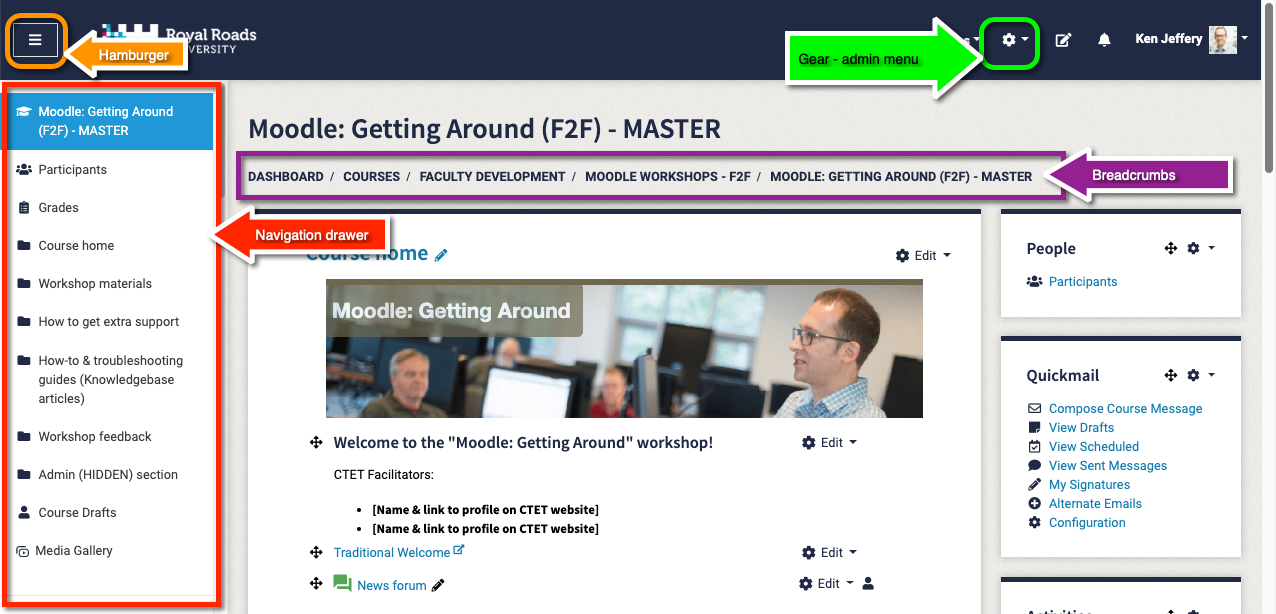Course Overview
| Site: | RRU Open Educational Resources |
| Course: | OER-Moodle: Editing & Enhancing (Self Study Resource) |
| Book: | Course Overview |
| Printed by: | Guest user |
| Date: | Friday, 26 December 2025, 11:06 PM |
How do I read this book?
Hello! You're now reading information in a Moodle Book. A book is one type of resource in Moodle that is used to hold content. That content can be text, images, videos - you name it.
Just like with real books that you can hold in your hand, Moodle books have many chapters in them. If you look to the right of this block of text content you'll notice a Table of Contents and you'll see that this chapter - called "How do I read this book?" - is bolded. That's because we're in this chapter right now.
Notice there are other chapters below that? If you click on their names, you'll be able to read the information in those chapters. Wherever you happen to be reading in the book, that chapter's title will be bolded.
Well, now you know how to read a Moodle book!
Oh, and just so you don't get stuck inside a book, we'll let you know that you can get back to the main page of the course by either:
- using the left Navigation drawer to visit another resource in the course. If you can't see the navigation drawer, click the hamburger button on the top left of your screen. This will open and close the navigation drawer.

- OR, like Hansel and Gretel did, using the "breadcrumbs" trail at the top of this page. (Just click on the name of the course to go back to the main course page.)
Course Outline
Overview
This version of Moodle: Editing and Enhancing is a self-study resource designed to help RRU core faculty, associate faculty, and staff build their basic Moodle knowledge and get up to speed on how to add and edit Moodle tools. This self-study resource was designed, built, and is supported by staff in RRU's Centre for Teaching and Educational Technologies (CTET). (We are the folks whose main role is to support faculty and quality teaching and learning at RRU.)
Learning Outcomes
Upon completion of this self-study, you should be able to do the following (and probably more!):
- Identify Moodle resources and activities and their applications
- Use various Moodle resources (e.g. books, pages, URLs, etc.) to add content to a Moodle course
- Use various Moodle activities to create engaging activities for students
- Edit existing resources and activities in a Moodle course
- Add media, such as images and videos, to a Moodle course
- Identify ways of getting additional Moodle support
After Completing This Self-Study Resource
There are, of course, many more activities that you can complete in Moodle other than what this self-study offers. We recommend that you reach out to your CTET connections as you work on building your real RRU course. Your CTET instructional designers (people who are experts in how to teach) and learning technologists (people who are experts in the tools we use to teach online) are the best resource to help you think about your course design and the Moodle (or other) tools that support it.
Optional Readings & Resources
These are resources that you don't need to read in depth during MEEO but we collect here for you for your skimming and future more in-depth reading and reference. If you are reviewing any of these materials and would like to open up a discussion about something you've seen here, please do! Feel free also to share with our group any other resources that you have found helpful.
Bonk, Curtis J. & Khoo, Elaine (2014). Adding Some TEC-VARIETY: 100+ Activities for Motivating and Retaining Learners Online. (This resource collects more than 100 activities under various main categories and suggests appropriate tech tools that can be used to deliver them.)
Royal Roads University OER server (If you are new to online course design you may want to review some example courses hosted on the RRU Open Educational Resources (OER) server.)
Elias, T. (2010). Universal instructional design principles for Moodle. The International Review Of Research In Open And Distance Learning, 11(2), 110-124. (An article that overviews some design elements for courses that would make courses accessible to all.)
Moodle.org Documentation (This is the general main site which houses Moodle documentation. Worth a look and something that you can dig into for future reference as you are becoming an advanced Moodle user. Remember that the information contained here will not always correlate to a higher education context.)
Video Making Resources
Introduction Video: Why Your Online Course Needs One
Quality Assurance/User Experience/Accessibility Resources
Guides for Quality Assurance at RRU from the CTET website (While you don't need to become an expert in the guides within this site, it is worth a browse now and a deeper look later when you are working on your real course. Know that CTET instructional designers, learning technologists and quality assurance personnel follow these guidelines when supporting you with your RRU course.)